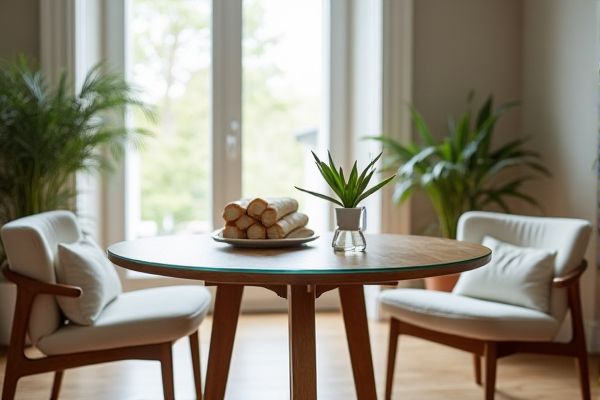
Glass tables offer a sleek, modern look with easy maintenance and a sense of spaciousness, while wooden tables provide warmth, durability, and timeless charm that fits various decor styles. Discover the key differences and find out which option best suits your living space by reading the rest of the article.
Table of Comparison
| Feature | Glass Table | Wooden Table |
|---|---|---|
| Material | Tempered or standard glass | Solid wood or engineered wood |
| Durability | Resistant to scratches, prone to shattering | Strong, may scratch or dent over time |
| Maintenance | Easy to clean, requires frequent wiping | Needs polishing and protection from moisture |
| Aesthetic | Modern, sleek, light-reflective | Warm, classic, natural texture |
| Weight | Generally lighter | Heavier and more robust |
| Cost | Moderate to high | Varies widely; can be affordable to expensive |
| Environmental impact | Less eco-friendly, manufacturing energy intensive | Biodegradable, renewable if sourced sustainably |
Introduction: Glass Table vs Wooden Table
Glass tables offer a sleek, modern aesthetic with a reflective surface that enhances light and space, making them ideal for contemporary interiors. Wooden tables provide warmth and durability with natural textures and a timeless appeal that complements various decor styles. Your choice depends on balancing durability, maintenance, and the desired atmosphere for your living space.
Aesthetic Appeal and Design Versatility
Glass tables offer a sleek, modern aesthetic with their transparent surfaces that enhance light flow and create an illusion of space, making them ideal for contemporary interiors. Wooden tables provide timeless warmth and natural texture, available in various finishes and styles that complement rustic, traditional, or modern decor. Both materials exhibit design versatility, with glass tables fitting minimalist or industrial themes and wooden tables adaptable through customizable stains, carvings, and shapes.
Durability and Longevity Comparison
Glass tables offer moderate durability with resistance to stains and scratches, but they are prone to cracking or shattering upon impact, limiting their longevity in high-traffic areas. Wooden tables provide superior durability, as hardwood varieties like oak, maple, and walnut can withstand heavy use and can be refinished or repaired to extend their lifespan. Over time, wooden tables generally outlast glass tables due to their robust construction and ability to endure daily wear and tear.
Maintenance and Cleaning Requirements
Glass tables require regular wiping with a glass cleaner to prevent fingerprints and smudges, making them easy to maintain but needing frequent attention for a spotless look. Wooden tables demand periodic dusting and occasional polishing or oiling to preserve their finish and protect against scratches, with sensitivity to moisture that can cause warping. Both materials benefit from using coasters and placemats to minimize damage and prolong the table's appearance.
Safety and Child-Friendliness
Glass tables pose safety risks due to their fragile nature and sharp edges, which can cause injuries, especially in homes with young children. Wooden tables offer a sturdier, more child-friendly option, providing durability and fewer hazards with smoother edges and less chance of breakage. Choosing a wooden table enhances your home's safety while maintaining a welcoming environment for kids.
Cost and Budget Considerations
Glass tables typically have a higher upfront cost due to the complexity of materials and manufacturing, often ranging from $150 to $600 depending on size and design. Wooden tables offer a broader price spectrum, from budget-friendly options around $100 to premium, handcrafted pieces exceeding $1,000, making them versatile for various budgets. Your choice should consider durability and maintenance costs, as glass may require more frequent cleaning and potential replacement, impacting long-term expenses.
Environmental Impact and Sustainability
Glass tables are often more environmentally friendly as they can be recycled multiple times without degrading quality, reducing waste and resource consumption. Wooden tables, especially those made from sustainably sourced or reclaimed wood, offer biodegradability and a lower carbon footprint during production compared to synthetic materials. Your choice of table can significantly influence your environmental impact by prioritizing materials with sustainable harvesting and recyclability.
Suitability for Different Spaces
Glass tables suit modern, minimalist spaces by enhancing light flow and creating a sense of openness, ideal for small apartments or contemporary offices. Wooden tables complement traditional, rustic, or cozy interiors with their warmth and natural textures, making them perfect for dining rooms and living areas. Both materials offer versatility, but the choice depends on space size, lighting, and desired aesthetic ambiance.
Functionality and Practical Use
Glass tables offer a sleek surface that is easy to clean and resistant to stains, making them ideal for environments requiring frequent maintenance and a modern aesthetic. Wooden tables provide durability and warmth, often featuring sturdier construction suitable for heavy use and a variety of design styles. The choice between glass and wood tables depends on the balance between visual appeal, cleaning requirements, and the expected wear from daily use.
Final Verdict: Which Table is Right for You?
Choosing between a glass table and a wooden table depends on your lifestyle and aesthetic preferences; glass tables offer a sleek, modern look and are easy to clean, making them ideal for contemporary spaces and minimal maintenance. Wooden tables provide durability, warmth, and a timeless appeal that suits traditional or rustic interiors while offering sturdiness for heavy use. Your decision should align with your space requirements, design style, and everyday functionality to ensure the table complements both your home and your needs.
 homyna.com
homyna.com